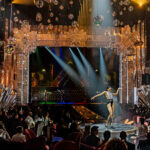It is important for an automated lighting programmer to be prepared for the programming sessions. This includes making many color mixing palettes or presets in advance. As the show is programmed, these colors will be utilized often and it is important that they are well-organized. When building color palettes, you should create a broad range of colors and various levels of saturation for each. It is also helpful if you can layout your palettes in an order that is logical to you. For example, color palettes one thru ten range from light amber through to red. Then eleven through twenty span from light cyan to Congo blue and twenty-one through thirty are light teal to deep green. Using a system such as this allows for a quick selection when the LD asks for a “fire orange” color.
Some programmers prefer to build color palettes that represent common gel colors. Then they assign the same palette numbers as used to refer to the gel numbers. For instance, deep blue might be stored in palette number eighty (for Roscolux 80) or fire red in number nineteen (for Roscolux 19). Another organization method is to visually layout the palettes horizontally in the “order” of the rainbow (ROYGBIV) with various levels of saturation in a vertical configuration. This allows for a quick on-screen selection without concern for palette numbers. A well-organized set of color palettes is essential for quick programming, and if used consistently on all productions, the layout can quickly become second nature.
– From Brad Schiller's upcoming November Feeding the Machines article.


